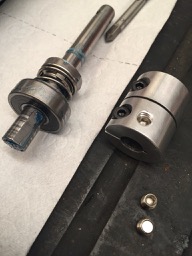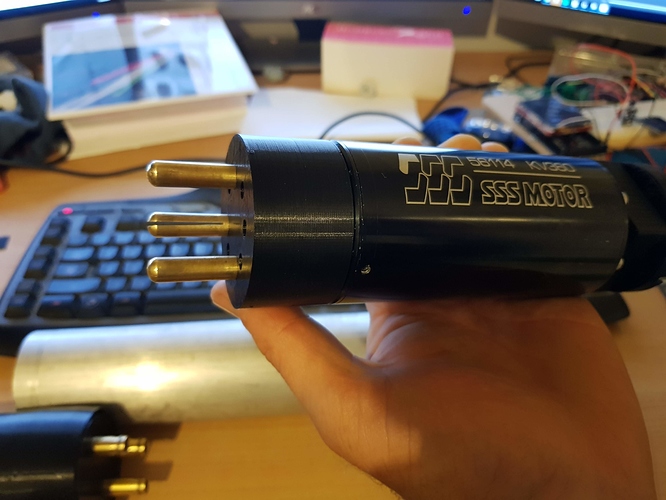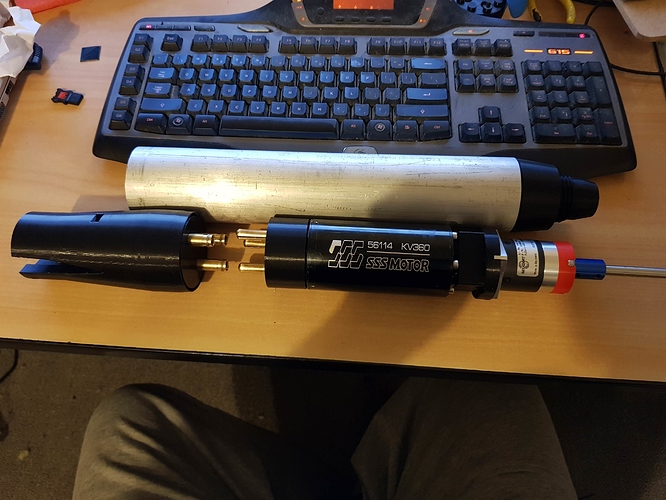I had a problem with my coupler between the gearshaft and propellershaft. I fixed it with to extra screws. And when I did the bathtub test and notice a big difference in power. 
Awesome! I thought the scenery looked familiar then you went right past my local ‘kohi’.
Been trying out a few new designs, i saw somewhere someone wanted me to share files
.
.
https://imgur.com/CMTK8CP
.
.
Hi, I would like to design and buil a removable system too. I like the work you did and i would like to know if u would accept to share me a plan with more detail ? The fixing between pod and mast is the most problem i’m facing, I need to make it waterproof, How did you do ?
Thanks
Lucas
Hey,
@Lucas41 if you click the link below the picture above you can download all the files. I used gasket sealant the same stuff you would use on your car to make the seal between the back pod and the mast mount
cheers
Dale
i think i may have come up with a plug in version too but still have to test how well it will work. it should make it easy to remove each motor and gearbox assembly
Hi, great idea, where did you get the plug and socket contacts from.
cheers
They are out of a PDL 56 series male and female socket. I have heaps of them in my van so figured I’d try use the pins
Nice idea using 56 series connectors! I am planning to do a pluggable system like this also. Have you tested yet?
What batteries do you use for your EFoil and skateboards? I’m looking to get in some 18650 cells to make a pack. Potentially using N.E.S.E battery system. Have you got 18650 cells into NZ? Any recommendations of suppliers?
I’m currently still using hobyking lipos for my mountain board and foil board as they are good bang for $$. I would reccomend
Samsung INR18650-30Q 3000mAh - 15A - 18650 - Li-ion - Rechargeable batteries | NKON
Had a mate import 50 or so 30Q cells form them and they all arrived, No fakes either
Interesting … So not the same price at all nkon store …
Some updates for anyone interested, hopefully the links work
so it seems the motor pod plug in version is working well after going out a few times
,
,
Added a boat hatch - the basted leaks so i added gasket sealant (the red shit you see in the next vid) and some marine grease.
very waterproof now, i did a trial by fire test in the surf and it seemed to be ok …for now lol. As a secondary safety i put everything in ip56 rated boxes with cable glands.
.
,
.
.
Added reed switch to cut the motor off via the receiver - i dont actually use it now, it was more of a pain in the ass to be honest lol. Added a switch for the self priming water pump i had it on the transmitter with a tx controlled relay but i soon found out that if you lend it to a friend to use they turn it off by mistake every time lol ![]()
.
.
,
,
First time out on this version of the build, i managed to get a vid form a interested bystander lol
,
,
.
.
currently building a new board and motor pod. The old windsurfer board is a tad big. also looking for a bigger more stable wing, so we will see how that all turns out.
Happy foiling my friends! ![]()
Quick question if anyone can help? what are you all doing to keep temperature down on your cables I’m using braded super worm 8agw silicone cables but still getting real hot, not hot enough to melt my xt90 connectors but hot enough to melt hot glue and solder. long term I think its gonna be a problem but ok for now with testing. Appreciate Any ideas and Thoughts
Cheers
Dale
@Sourcecode
Hi Dale,
heat is generated by electric current in the cables. The thermal power is P = R * I² (R is resistance of the cable, I is current). To lower the temperature of the cable the best way will be to change them from 8AWG to 6 AWG or better. According to my table 8AWG means 8,34 mm² cross section area, The specific resistance of cable copper is 0.0175 Ohm * mm² / m, so 1 Meter of 8AWG has a resistance of 0.0021 Ohm. If that cable has to conduct a current of say 200 Ampere, the power loss will be P = 0.0021 Ohm * 200 Ampere * 200 Ampere = 84 Watt. (Compare this with e.g. a soldering iron of 40 Watt.)
6AWG is 13.3 mm² -> 53 Watt, 4AWG is 21.2 mm² -> 33 Watt.
I beg your pardon if you knew all this. But because I don’t see that any kind of heat sinks would be manageable in an application like this, the reduction of the generation of the heat is the only way I think. (You don’t want to reduce the current, I suppose.)
Hi @Sourcecode, we know the formula  but I personally never calculated the actual power loss on the cable of 1M and just was amazed how significant it is even with 8AWG. Thanks for your detailed explanation!
but I personally never calculated the actual power loss on the cable of 1M and just was amazed how significant it is even with 8AWG. Thanks for your detailed explanation!
As I know some people let the water flow to the mast so it is filled with water where most of the cable length is located, then it will allow to dissipate part of the heat to the water
The calculation I made above (based on Ohm’s law) is a DC calculation which fits to the cables between batteries and ESC. The three-phase current between ESC and motor is a bit different and the losses depend on the output of the ESC and the characteristics of the motor. (As far as i know, the DC values multiplied by 1,732 should be the sum of the losses of the 3 phase cables, assumed the current is equal.)
Thanks for that explanation very helpful!
Im thinking since my ESC is 22s capable im going to try running at 16s and 18s and see how much it will reduce the heat by. Hopefully by upping the voltage it will reduce the current and in turn less heat on the battery side of the ESC. will also try bigger cables maybe 6AWG and see how that goes
Reducing the current while increasing the voltage accordingly is a way to transmit the same power. But this means also to increase the danger of an electric injury in a case of fault. AFAIK you would leave the area of a voltage near safety low-voltage and enter a range of hazardeous voltage - espacially to a human body in (salt) water.
Secondly the same motor would respond to a higher voltage by a higher rpm. This would affect the hydrodynamics of the propeller etc.
We ran 16S and your amps will drop way off and run cooler for sure and you will get more power/torque out of the motor also. We gained 10% more torque/thrust with 16S. Also keep in mind your RPMS will rocket higher, you will need a lower KV or limit your ERPM with your ESC to cap RPMS from damaging your gear etc…
Hi using a well matched aluminium prop can reduce amp draw significantly. 16s in water is dangerous even 12s gave us gentle shocks while wet


